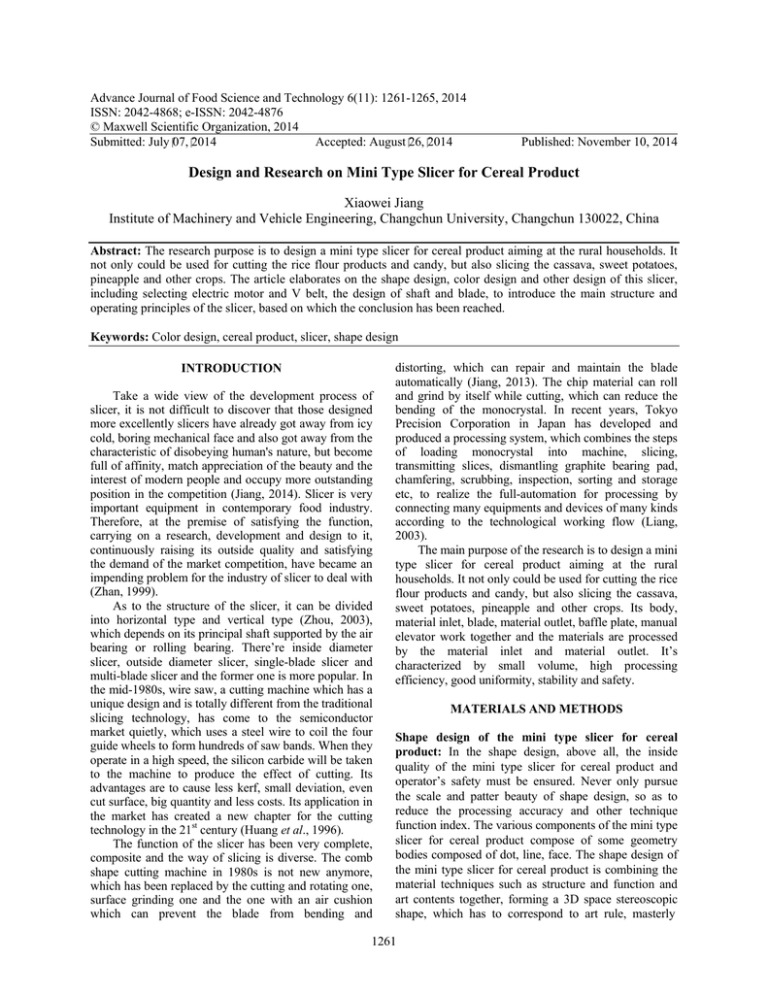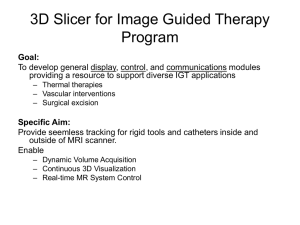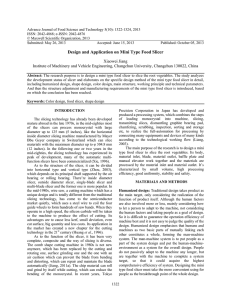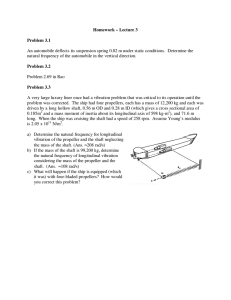Advance Journal of Food Science and Technology 6(11): 1261-1265, 2014
advertisement

Advance Journal of Food Science and Technology 6(11): 1261-1265, 2014 ISSN: 2042-4868; e-ISSN: 2042-4876 © Maxwell Scientific Organization, 2014 Submitted: July 07, 2014 Accepted: August 26, 2014 Published: November 10, 2014 Design and Research on Mini Type Slicer for Cereal Product Xiaowei Jiang Institute of Machinery and Vehicle Engineering, Changchun University, Changchun 130022, China Abstract: The research purpose is to design a mini type slicer for cereal product aiming at the rural households. It not only could be used for cutting the rice flour products and candy, but also slicing the cassava, sweet potatoes, pineapple and other crops. The article elaborates on the shape design, color design and other design of this slicer, including selecting electric motor and V belt, the design of shaft and blade, to introduce the main structure and operating principles of the slicer, based on which the conclusion has been reached. Keywords: Color design, cereal product, slicer, shape design INTRODUCTION Take a wide view of the development process of slicer, it is not difficult to discover that those designed more excellently slicers have already got away from icy cold, boring mechanical face and also got away from the characteristic of disobeying human's nature, but become full of affinity, match appreciation of the beauty and the interest of modern people and occupy more outstanding position in the competition (Jiang, 2014). Slicer is very important equipment in contemporary food industry. Therefore, at the premise of satisfying the function, carrying on a research, development and design to it, continuously raising its outside quality and satisfying the demand of the market competition, have became an impending problem for the industry of slicer to deal with (Zhan, 1999). As to the structure of the slicer, it can be divided into horizontal type and vertical type (Zhou, 2003), which depends on its principal shaft supported by the air bearing or rolling bearing. There’re inside diameter slicer, outside diameter slicer, single-blade slicer and multi-blade slicer and the former one is more popular. In the mid-1980s, wire saw, a cutting machine which has a unique design and is totally different from the traditional slicing technology, has come to the semiconductor market quietly, which uses a steel wire to coil the four guide wheels to form hundreds of saw bands. When they operate in a high speed, the silicon carbide will be taken to the machine to produce the effect of cutting. Its advantages are to cause less kerf, small deviation, even cut surface, big quantity and less costs. Its application in the market has created a new chapter for the cutting technology in the 21st century (Huang et al., 1996). The function of the slicer has been very complete, composite and the way of slicing is diverse. The comb shape cutting machine in 1980s is not new anymore, which has been replaced by the cutting and rotating one, surface grinding one and the one with an air cushion which can prevent the blade from bending and distorting, which can repair and maintain the blade automatically (Jiang, 2013). The chip material can roll and grind by itself while cutting, which can reduce the bending of the monocrystal. In recent years, Tokyo Precision Corporation in Japan has developed and produced a processing system, which combines the steps of loading monocrystal into machine, slicing, transmitting slices, dismantling graphite bearing pad, chamfering, scrubbing, inspection, sorting and storage etc, to realize the full-automation for processing by connecting many equipments and devices of many kinds according to the technological working flow (Liang, 2003). The main purpose of the research is to design a mini type slicer for cereal product aiming at the rural households. It not only could be used for cutting the rice flour products and candy, but also slicing the cassava, sweet potatoes, pineapple and other crops. Its body, material inlet, blade, material outlet, baffle plate, manual elevator work together and the materials are processed by the material inlet and material outlet. It’s characterized by small volume, high processing efficiency, good uniformity, stability and safety. MATERIALS AND METHODS Shape design of the mini type slicer for cereal product: In the shape design, above all, the inside quality of the mini type slicer for cereal product and operator’s safety must be ensured. Never only pursue the scale and patter beauty of shape design, so as to reduce the processing accuracy and other technique function index. The various components of the mini type slicer for cereal product compose of some geometry bodies composed of dot, line, face. The shape design of the mini type slicer for cereal product is combining the material techniques such as structure and function and art contents together, forming a 3D space stereoscopic shape, which has to correspond to art rule, masterly 1261 Adv. J. Food Sci. Technol., 6(11): 1261-1265, 2014 Fig. 1: Cake slicer Fig. 2: Cat ear slicer Fig. 3: The color design of slicer satisfying the request of environment and function makes use of shape composing principle and masters shape appearance characteristic and forming psychology and vision error of related shape, that is important means to acquire the slicer of generous beauty and novel style (Qiu, 2005). The shape design of the mini type slicer for cereal product should be scale coordination, balanced steady and take" unity " as king, "change" as assist and the line type has to be simple and generous, giving person with comfort, coordination and felling of dynamic in quiet. Proportion: The body proportion of the mini type slicer for cereal product means the contrasting relationship of size between the whole and the local and the local and the detail, pursuing visual ratio beauty. The form surface is mostly rectangular and the aspect ratio could choose golden ratio (1: 0.618) or root-mean-square ratio (1:√n, n = 2, 3, …). In the shape design of the mini type slicer for cereal product, each part usually adopts the equal or similar proportion, which is easy to get harmonious, comfortable effect, as shown in Fig. 1. Color design of the mini type slicer for cereal product: The color design is an important constituent part of the design of the mini type slicer for cereal product, as color has more ocular, stronger and more attractive magic power than the body. The color could firstly influence the person's sense organs than the body, moreover, that could raise operator recognizing and watching degree to some operation controls, show instrument and appearance by making use of vision recognizing effect and psychology of color, sequentially, the function of these device could be well developed and the mental request of operator could be satisfied and the work efficiency could be enhanced, in the meantime, the occurrence of production could be also reduced. The color design of the mini type slicer for cereal product should follow the following few important points. Satisfy the request of environment and function: The color should well express the function characteristic of product and mutually coordinate with the use environment. If the greasy dirt of use environment is serious, usually the dark color is proper for bearing greasy dirt. The color of the panel of slicer generally properly use the neutral base color of low bright degree and low pure degree, contrasting with component color, so as to enhance the vision recognizing degree. The panel should have no strong reflection and dazzle light. The color of display part should be obvious and refreshing, but not dazzle eye. The color of caution part should be fresh and gorgeous to come into notice and the color of concealment part should be quiet, as shown in Fig. 3. Satisfy the request of man-machine coordination: The color design of slicer should well embody the relation of man-machine coordination, so as to make operator’s mood pleasant, have a sense of security, don't easily produce fatigue and then attain to the purpose of operating accurately and enhancing production efficiency. For example, generally, the base and body of slicer properly adopt heavy and solid deep color, not only bearing dirty but also making person have the dependable sense of stability to machine. The workbench, sliding plate and other parts are the components that person usually use, which properly adopt bright color, so as to get rid of depressed feeling, satisfying the request of operating accurately and manmachine coordination. Equilibrium: Equilibrium is the processing approach for the asymmetric shape of slicer. According to the Value the choice of tone: The choice of main tone of principle of mechanical equilibrium, the asymmetric slicer is a problem of very importance; the different tone shape uses the fulcrum to show the equilibrium sense will form different art effect. In matching color of slicer, that the form size and the product to the fulcrum having main tone can seem to be to unify. The color is distance is equal, achieving balance effect. In the more little, the main body characteristic is more strong, meantime, it also will have well-organized beauty and the decorate characteristic is more good and the external dynamic beauty of motion in quiescence and quiescence form relation of slicer is more unify. Contrary, the color in motion, as shown in Fig. 2. In addition, it also could strengthen the equilibrium effect by color, texture and matches more much, causing the color more disorderly, surface decoration (Fu, 2002). so that it is difficult to adjust generally, the main body 1262 Adv. J. Food Sci. Technol., 6(11): 1261-1265, 2014 Fig. 4: The color design of slicer matching the new age request of appreciation beauty characteristic is unclear and the harmonious effect is broken. The choice of tone still needs to notice whether unique beauty. It needs to hold tight people's mental request for the color of food slicer, transform the tone of slicer to make it produce an unusual attraction, in the meantime, increase the category of tone to satisfy people's fondness for different colors. Moreover, the base, the body and other big pieces of slicer are suitable to use a low pure degree color as the main body color and use clear, elegant and clean color to unify overall situation to make the main tone definite. Using little area of high purity color to embellish to make the whole seem to be abundant, change and organic. The whole color generally uses monochrome or two sets of colors, not more than three sets of colors (Fu, 2002). Notice novelty: The color design of slicer should notice novelty and creativity to make it have vitality and more competitiveness. The color of slicer not only can satisfy the request for appreciating beauty, under the particular condition, but also has strong influence, which can cause the transfer of people's emotion and interest to attract people's attention. For example, on an international industrial product exhibition, a red slicer produced by some country appeared in the mechanical exhibition hall. Though the red is not the color that the slicer consistently uses, the factory surprisingly adopted red color to decorate food slicer, causing the purchaser to crowd in its vicinity and then understood its function characteristics, which produced a surprising sensation effect and made its order enormously exceeded other nation. It is thus clear that the novelty of color design is very important. Match the new age request of appreciation beauty: With the progress of the age, the improvement of people's living standard and the increase of cultural art accomplishment, the appreciating beauty standards also change. In a certain period or a certain region or world scope, some colors are popular of people and are extensively popular, becoming the "popular color". The "popular color" has a strong age characteristic, as a result, in a period, it become the color which is used extensively. The color design of slicer also should sufficiently consider using the "popular color" to accord with the age request, as shown in Fig. 4. interchangeability, can prevent the dust, iron scurf and some other foreign substance intruding into the interior and is B class insulation. It requires the temperature of working environment can’t exceed +40°C, the relative humidity can’t exceed 95%, the altitude can’t be above 1000m, the rated voltage shall be 380v and the frequency shall be 50 Hz, which only applies to the mechanical machine without special requirement (Jiang, 2014). Selection of V belt: The narrow V belt uses synthetic fiber rope or steel wire as its bearing bed. Compared with the ordinary V belt, when they have the same thickness, its width is 30% less. The narrow V belt’s transmission power is stronger than the ordinary one’s, which allows high speed and bending frequency, has a shorter transmission center distance and is suitable for the transmission of high power and compactnessrequired structure. The outstanding character of household slicer is light and handy, so the narrow V belt is chosen in its design. Working coefficient KA = 1.0 (Mechanical Design Manual, form 12-1-67). Transmission power P = 0.75KW, design power of the synchronous belt Pd = KaxPd = 0.75×1.5KW = 0.75kW. Efficiency of the transmission belt = 0.9, efficiency of the shaft transmission = 0.75×0.9 = 0.7kW. • Transmission ratio: Rotational Speed of principal shaft = Rotational Speed of big pulley = 425 r/min Rotational Speed of motor = Rotational Speed of small pulley = 910 r/min = 2.14 Transmission ratio i = n1 = n2 425 • Selection of the small pulley’s diameter: Rotational Speed of small pulleyn1 = 910 r/min. The dimension of the pulley’s diameter is calculated by the speed reducing ratio, which is designed according to the working rotational speed and motor’s rotational speed. Working Rotational Speed/Motor’s Rotational Speed = Dsriven Pulley’s Diameter/Driving Pulley’s Diameter×0.98 (sliding coefficient): Initial small pulley’s datum diameter dd1≥(dd) min, (dd) min = 90 mm dd1 = 140 mm shall be chosen according to Mechanical Design Manual, form 14.1-8 Checking belt speed: o o Selection of an electric motor: It’s a good choice to use o Y series motor which has an international 1263 V1= πd d 1n2 = 3.14 × 140 × 910 = 6.67m/s 60 × 1000 60 × 1000 Small Pulley’s Rotational Speed 5<V1<25m/s Calculation of the Big Pulley’s datum diameter dd2 = idd1 = 2.14×140 = 299.6 mm Adv. J. Food Sci. Technol., 6(11): 1261-1265, 2014 o • Calculating the center distance a and choose the narrow V belt’s datum length Ld. According to the overall dimension’s restrictive condition or the required center distance of the transmission belt, based on formula (8-20), the initial center distance is a0: 0.7(dd1+dd2)≤a0≤2(dd1+dd2) 307.72 ≤a0≤ 879.2 • • Finalizing the center distance a0 = 400mm Calculation of the relevant belt’s length Ld0 Ld0≈2a0+π/2(dd1+dd2) ≈800+690.2+15.9 ≈1506.1mm The belt’s datum length Ld is chosen from form 8-2 1600mm. Calculation of the center distance a and its fluctuation range Transmission’s actual center distance is approximate to: (F0) min = 500×(2.5-Kα)×Pca/Kα×z×v+qv2 = 500*(2.5-0.925)×0.825/0.925×2×6.67+0.1×6.667 = 53N • Fp = 2zF0sinα1/2 = 213N Design of the shaft: The design of the shaft’s structure depends on the following several aspects: the configuration, fastening, assembling and disassembling of components in the shaft and the workmanship of the shaft. • a = a0+(Ld-Ld0)/2 = 400+(1600-1506.1)/2 = 447 mm Considering the manufacture error of the pulley, belt’s length error, elasticity of the belt and the need of supplementing the tension because of the loose belt, the fluctuation range of the center distance is normally given as the following: • amin = a-0.015Ld = 447-0.015×1600 = 423 amax = a+0.03Ld = 447+0.03×1600 = 495 • Checking the wrap angleα1 on the small pulley: The wrap angle α 1 on the small pulley is smaller than the wrap angle α 2 on the big pulley and the total friction force of the small pulley is relatively less than the big pulley’s, so sliding can only happen to the small pulley. In order to improve the transmission working ability, the following formula should be used: • Α1≈180°-(dd2-dd1)57.3°/a≥90° ≈180°-(299.6-140)57.3°/447=159.5° • • The actual initial pulling force of the belt shall be larger than 53N Calculation of the force Fp in belt transmission: In order to design the bearing of the pulley, the force Fp imposed on the shaft in belt transmission needs to be calculated: Finalizing the number of the belts: In order to make each V belt bears strength evenly, the number of the belts should not be too many, normally less • than 10, or else, the belt with larger cross-sectional area shall be chosen to reduce the number. Here the number of the belts is z = 2. Calculation of belt’s initial pulling force F0: Considering the influence of the centrifugal force and wrap angle, the minimum initial pulling force of each V belt shall be: 1264 Draw up a component-assembly scheme: Predetermine the principal components’ assembly direction, sequence and interrelation. Lock ring and bearing are on the shaft successively. The ring of the bearing is used to locate the direction of shaft, which is suitable to fix the components at the end of shaft and can bear stronger axial force. The fixation of the components on the shaft can be divided into two directions: The fixation of the shaft’s direction: the transmission of torque and motion, which can use pinch fit (bearing inner ring). The fixation of the shaft’s direction: to avoid the axial movement which is produced when the components are working, the round nuts can be used. The shaft’s end part shall have a 45°chamfer to make it centering during installation, which can prevent the sharp edge cutting hands. Material of shaft: The roughcast of shaft is normally made from round steel or forgings. The shaft is often working under alternative stress, so the requirement for material is as the following: high strength, good rigidity, small sensitivity of stress concentration, anti-fatigue, easy to process and some of the shafts have a high standard for its surface. Medium carbon steel 35 or 45 and alloy steel 20Cr or 40Cr etc are mainly the materials of shafts. The most frequently used one is 45 steel which has a higher comprehensive mechanical performance, so the 45 steel is used in this design. Definition of shaft shoulder: On the shaft only the sleeve and bearing are installed, the shoulder is used to locate. If the shoulder is used, it’ll make the diameter of the shaft increase. And because of the sudden change of cross section, the stress concentration will be caused at the shoulder area. In addition, too many shaft shoulders are not good for processing, so shoulder location is usually used Adv. J. Food Sci. Technol., 6(11): 1261-1265, 2014 • when the axial force is stronger. Positioning of the shaft shoulder’s height is normally used h = (0.07 ~ 0.1) d, d is the diameter of the shaft which matches the component. The positioning shoulder height of rolling bearing must be lower than the height of bearing inner ring’s section to make it easy to dismantle bearings. The height of the shaft shoulder can consult the Manual for the installation dimension of bearings. Definition of shaft’s length: In order to make the components which have pinch fit with the shaft easy to assemble, the pressure inlet end of the related shaft segment shall be tapered, or different dimension tolerance can be used on two parts of the same shaft segment. When the length of shaft is defined, try to make the structure compact and at the same time make sure the components have space for assembly and adjustment. The length of each segment of the shaft is mainly decided by the axial dimension of the part where each component working with the shaft and the necessary space of the adjacent component (Fan and Chen, 1994). Design of the blade: The size of the material inlet decides the length of the blade. When it is 82 mm, the length of the blade L>82mm will be OK. L = 120 mm will satisfy the operating requirement. RESULTS AND DISCUSSION • o o o Main structure: The slicer consists of material inlet system, cutting system, material outlet system and manual elevator system. The material inlet system is very simple; because it’s a household slicer which doesn’t have a large quantity to slice, the manual feed is used. It not only lowers the costs, but also reduces the size of the slicer (He et al., 2013): Cutting system: It consists of blade, blade rest, principal shaft and a pair of pulleys. The electric motor transmit the power to the pulley and then to the principal shaft which will rotate the blade adapter and it will drive the blade to do circle movement, so that the materials can be sliced. Material outlet system: In order to make sure all the slices of the materials come out, the size of the baffle plate shall be a bit bigger than the mouth of the material outlet, which not only can make the materials drop accurately, but also can discharge the material in time. Elevating system: It can make the slices processed by the slicer have even thickness, neat cut surface, more accurate and convenient to adjust the thickness. • Working principle: Though circle movement of the blade and materials’ manual feeding to realize the continuously slicing of material. The electric motor transmits power to the principal shaft through belt and the principal shaft will rotate blade rest, manually feeding the slicer and the material will be sliced. CONCLUSION The design of the mini type slicer for cereal product is in accordance with principles of ergonomics, easy to operate, convenient, safe and high stability. The shape and appearance, which is simple and decent, occupy less space and easy to carry, has greater aesthetic value. The overall structure is concise and reasonable. ACKNOWLEDGMENT This research is supported by the Twelfth Five-Year Science and Technology Research Project of Education Department of Jilin Province under the grant No. 2014530. REFERENCES Fan, Y. and Z. Chen, 1994. Brief Manual of Metal Cutting Machine Tool. Mechanical Industrial Press, Beijing, pp: 163-354. Fu, L., 2002. Research on Modeling Design of Industrial Product. Jilin People Press, Changchun, pp: 129-133. He, W., P. Li, Z. Yuan, Y. Zhang, D. Xing, X. Xiang and H. Lu, 2013. Effect of direct sowing rates on mid-season “rice feng-liang-you-xiang-1”. Adv. J. Food Sci. Technol., 5(4): 422-424. Huang, G., Y. Qu, X. Mo and F. Zhu, 1996. Design and research of ginseng microtome. J. Jilin Agric. Univ., 18(3): 90-93. Jiang, X., 2013. Design and research on household food slicer. Adv. J. Food Sci. Technol., 5(10): 1296-1300. Jiang, X., 2014. Development design of new age food machinery. Adv. J. Food Sci. Technol., 6(1): 140-143. Liang, R., 2003. Design of small-sized cereal product slicer. Equip. Mod. Agric., 10: 64-66. Qiu, S., 2005. Modeling Design Basis. Tsinghua University Press, Beijing, pp: 55-64. Zhan, X., 1999. Art Design of Machine. Hunan University Press, Changsha, pp: 39-56. Zhou, Y., 2003. The Design of Vertical Pineapple Slicer. Machine and Design, pp: 38. 1265





